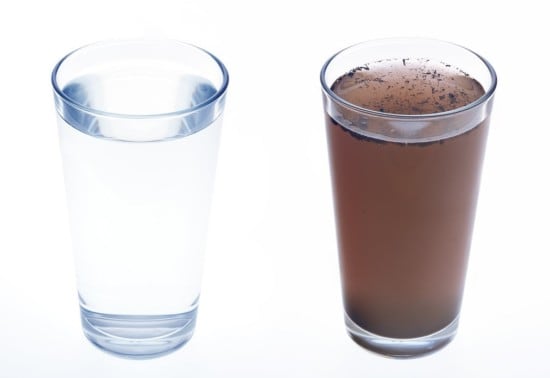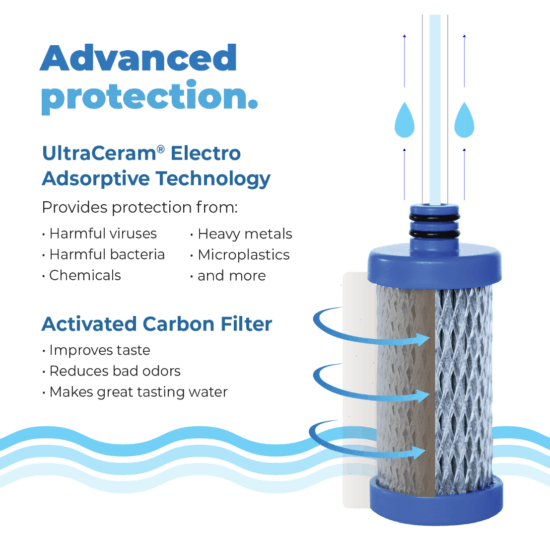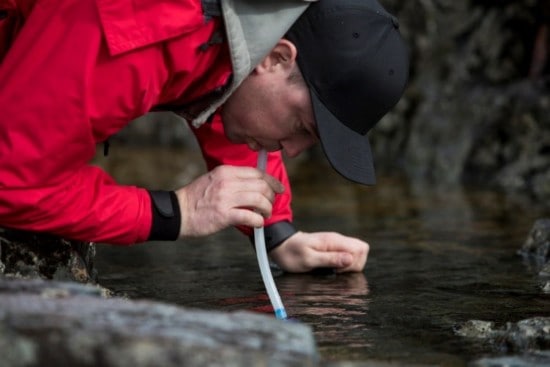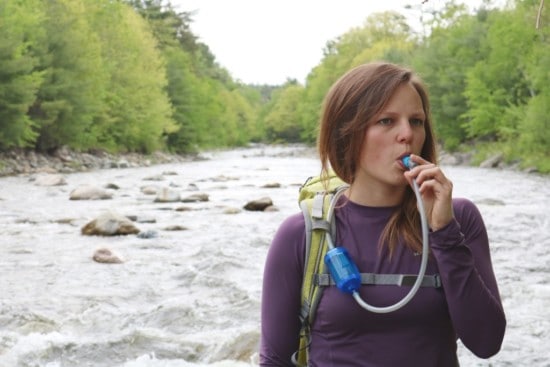Why Filtering Your Water Isn’t Enough: Water Filters vs. Purifiers
Clean Water Isn’t Safe Water
There’s something amazing about watching a water filter turn nasty, brown water into clear, sparkling-clean water right before your eyes. Unfortunately
though, this clean appearance doesn’t mean the water is safe to drink.

In fact, most of the health hazards that exist in water (aka waterborne pathogens) are microscopic, meaning they’re invisible to the naked eye. Some of these hazards are so tiny that traditional water filters aren’t effective at removing them.
Backcountry Water Safety
Staying hydrated with pure water is one of the most important pieces to having a successful adventure, whether you’re backpacking, camping, hiking, or traveling abroad. That’s why it’s important to consider the benefits of water filters vs. water purifiers when choosing a personal water treatment system.

In this article, we’ll take a closer look into what
waterborne pathogens exist and how they can be removed so you can have confidence the water you’re drinking not only looks clean but is actually pure, safe drinking water.
Microscopic Dangers
Viruses

Viruses are parasitic organisms 100 times smaller than bacteria, with most
viruses measuring between 0.02 – 0.5 microns in size. They are incredibly hardy organisms that may survive through both freezing and drying. Waterborne viruses that cause disease in humans include rotavirus, norovirus, and Hepatitis A.
Bacteria

Bacteria are single-celled organisms that exist almost
everywhere on earth. Some bacteria help humans, while others are the culprits for many waterborne diseases. These include E. coli, salmonella, and dysentery, none of which make for an enjoyable backcountry experience. Most bacteria range in size from 0.2 to 10 microns (1 micron = 0.00039 inches).
Protozoa & CystsProtozoa
are one-celled animals that live mainly in water. When they infect humans, they can cause diseases ranging from mild to life-threatening. Common parasitic protozoa include giardia and cryptosporidium.
Some protozoa form cysts, a protective wall that makes them resistant to disinfectants commonly used in treating drinking water. Cysts are generally between 2 and 50 microns in size.
Chemicals
Not all waterborne health hazards are alive. Chemicals like chlorine, benzene, and chloroform may be present in water and represent a health concern in high concentrations.
Heavy Metals
This health hazard is certainly not the least dangerous. Heavy metals that find their way into water include lead, arsenic, and chromium. The health danger they represent should not be ignored.
Sediment
No one wants to drink water with dirt floating in it.
However, dirt isn’t why we included sediments on this list of microscopic dangers. Microplastics are tiny plastic particles smaller than a sesame seed that can be found in water due to pollution.
Microplastics are increasingly found in drinking water. Though they have not been proven to be a health danger, there is concern that chemicals or other pathogens may catch a ride on these tiny plastic pieces into your body, making removing them from your water the safe choice.
How Water Filters Work
With all those invisible dangers floating around in water, it’s no wonder water filters for hiking, backpacking, hunting, and international travel exist. These filters provide valuable protection but,
unfortunately, may not be enough to protect you due to the very nature of how filters work.
So how does a water filter work?
Most water filters act as sieves (imagine a much
smaller version of the colander you probably have in your kitchen).

They physically strain out waterborne hazards by forcing the water (using suction or gravity power) through a membrane that has tiny holes.
These holes are typically 0.2 microns in size. The 0.2 micron size is big enough to let the water molecules through but small enough to trap sediment,
bacteria, and protozoa/cysts.
If you’ve found it difficult to drink through a water
filter, it’s because forcing the water through the tiny holes using the power of your own suction is a lot of work – and the smaller the holes, the more work
it is.
Unfortunately, even the tiny 0.2 micron holes in most water filters aren’t small enough to catch viruses, heavy metals, or chemicals, meaning you could still get sick drinking filtered water. Filtering your water
isn’t enough to be confident that what you’re drinking is safe. That’s where RapidPure water purifiers and the benefits of water purification come in.
RapidPure: More Than a Filter
RapidPure’s line of water purifiers goes a step beyond water filters by removing not only
bacteria, sediment, and protozoa/cysts, but also viruses, heavy metals, and chemicals so you can be sure your water is safe to drink, no matter where you
travel.

Water Filters vs. Water Purifiers
| Removes… | Leading Water Filters | RapidPure® Water Purifiers |
| Sediment | Yes | Yes |
| Bacteria | Yes | Yes |
| Protozoa/Cysts | Yes | Yes |
| Viruses | No | Yes |
| Chemicals | No | Yes |
| Heavy Metals | No | Yes |
RapidPure water purifiers look a lot like traditional water filters, but like with the waterborne pathogens it removes, the difference is in what you can’t see.
RapidPure’s purification membrane uses the latest in water treatment technology, called UltraCeram®. As the water passes through RapidPure’s membrane, the UltraCeram acts like a magnet, attracting and trapping waterborne pathogens by targeting the negative electromagnetic charges these
contaminants emit.

With the viruses, bacteria, protozoa/cysts, heavy metals, and chemicals removed by the UltraCeram, the only thing the RapidPure membrane has to physically strain out is the sediment. This allows the pore size to be much larger than 0.2 microns, meaning the force needed to push the water through the holes much less. You read that right – RapidPure purifiers create safer water while being easier to drink through!

Travel Far & Drink Safe
So whether you’re prepping to thru-hike the AT, travel to South America, or simply enjoy some backcountry water in your own state, make sure you’re in the know what dangers exist and how to prevent them. Packing and using a RapidPure water purifier is only one piece of travel safety (albeit an important one). A little research and the right gear can help you go a long way – wishing you safe travels and amazing adventures ahead of you.

The RapidPure Scout is an inline purifier that works with your hydration pack.
